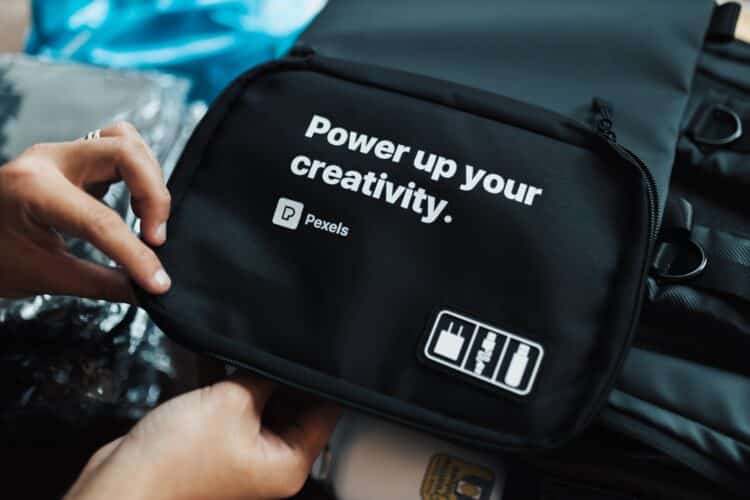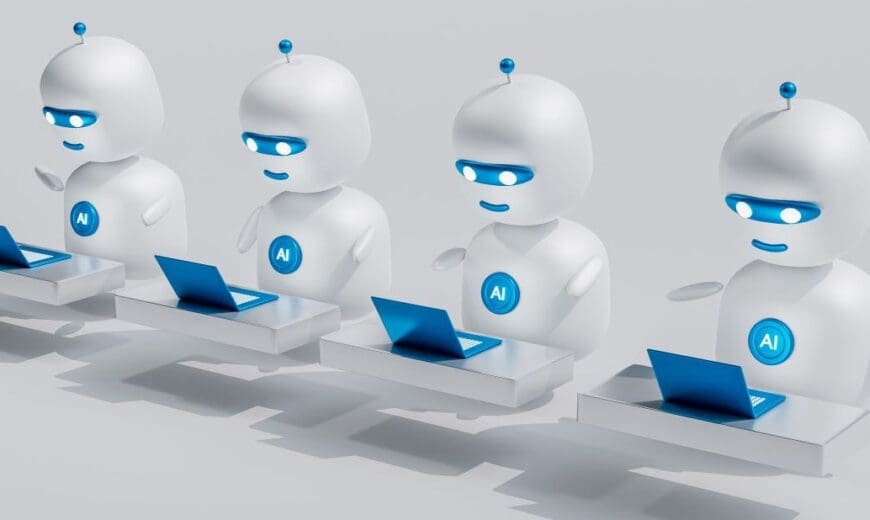
Stacie Harshbarger Gass, marketing and operations manager at Chicago-based distributor Printable Promotions (PPAI 102841, D4), has a new favorite colleague: ChatGPT.
The nearly 25-year industry veteran relies upon the artificial intelligence (AI)-powered chatbot for a variety of daily tasks, such as creating hashtags for social media posts, writing subject lines for emails and generating keywords for web pages. When she had complicated data to display in a meeting, ChatGPT told her what type of graphs to use. And when she had to fix some code on the company website? ChatGPT had the answer for that, too.
“I have ChatGPT open all the time and constantly ask it questions,” Gass says. “I can also have it proofread and check for tone. If I write something really boring, but it had all the points I wanted to make, I’ll put it in ChatGPT and tell it to make it more Gen Z or to sound like a pirate wrote it, just so we get a different perspective and have fun with it.”
Rapping Puppets
Since bursting onto the scene in November 2022, ChatGPT has been all the rage in the business world, as professionals consider how the tool can make their lives easier.
Although ChatGPT has become the fastest-growing consumer application in history, several other generative AI tools have hit the market, such as Google’s Bard, Adobe’s Firefly, OpenAI’s DALL-E 2 and Midjourney.
 As Gass and other industry pros have proven, generative AI is already impacting the promotional products industry in various ways.
As Gass and other industry pros have proven, generative AI is already impacting the promotional products industry in various ways.
Earlier this summer, the self-described “creative weirdo and chaos wrangler” at Printable Promotions lived up to her moniker. Gass asked ChatGPT to write a rap in the style of Jay-Z about the screen-printing process from the perspective of T-shirts being printed. Taking it one step further, she found people on freelance marketplace Fiverr who, for the paltry sum of $100, would have puppets perform the rap in a professionally produced video.
Jim Henson would’ve been proud.
“Drawing people in with keywords is one thing,” Gass says, “but you have to get them to stay. You’re going to have to do something creative and different if you want people to do business with you.”
In addition to posting the video on social media, the company included it in an email marketing campaign and used it as a landing page for another project. Plus, sales representatives benefited from having it be a conversation starter with clients.
“Our clients consistently say they like getting our marketing because it makes them laugh,” Gass says. “Even if they don’t buy anything from that email, they’re paying attention to us. Everybody is so fatigued because we’re bombarded with marketing in our lives, so anytime someone says, ‘I like getting your email campaigns,’ that’s amazing. I love being able to do things like that with a subliminal business message that isn’t necessarily a hard sell and entertains people for a minute out of their day.”
Changing The Game For Promo
Two weeks before OpenAI launched ChatGPT, Chicago-based distributor Givenly.com (PPAI 698869, D1) introduced a gift catalog generator powered by a proprietary AI algorithm.
End users enter a few details about their desired price point and what occasion they’re buying for. For example, someone could type in “back-to-school products under $100” and the generator will produce a curated selection of gifts. For a truly customized experience, Givenly.com allows users to attach a personalized video greeting, welcome email or landing page to the selection of gifts.
 “I realize AI is going to change the game completely for promo, gifting and every application under the sun,” says Mark Mancini, founder and CEO of Givenly.com. “We’re fully embracing it and exploring more ways to integrate AI.”
“I realize AI is going to change the game completely for promo, gifting and every application under the sun,” says Mark Mancini, founder and CEO of Givenly.com. “We’re fully embracing it and exploring more ways to integrate AI.”
Mancini plans to transform Givenly.com’s gift redemption platform into a software-as-a-service (SaaS) for distributors eager to capitalize on corporate gifts and incentives. In fact, he’s even pitched Brand Bot, a white-label solution capable of instantly deploying itself into the current technology stack of most distributors. The AI-based system delivers a scalable product consultation and sales website able to intelligently guide the consumer throughout the buying process.
- It will deliver a simple e-commerce layout for the consumer, driven entirely by human-like conversation powered by AI, which is capable of performing discovery, recommending products, facilitating virtual proofs and answering complex questions.
- Brand Bot can also offer a backend order management tool to communicate order statuses and facilitate any friction points during the fulfillment and post-sale stage.
- Plus, there’s an automated marketing tool powered by AI, which is not only branded with a distributor’s logo and colors, but also integrated with social channels and mass emailing systems for continuous promotional outreach and engagement.
“Because the promo industry generally skews older, adoption will be more from platform providers selling to that crowd than that crowd adopting anything themselves,” Mancini says. “I don’t really see the average distributor adopting AI and finding the right way to use it. It’s just not going to happen outside of companies like Givenly.com, OrderMyGear and others who can supply the technology to the distributor to do their jobs more effectively.”
Instinct Versus Data
Most product recommendations made by a distributor are driven by instinct rather than data, according to Eric Hamlin, head of swag at New York City-based distributor Snappy (PPAI 816234, D6).
Hamlin says that industry veterans rely on three factors when selling to end users:
- Recency (“I just sold this hoodie to another client and they liked it, so I bet my other clients will like it.”);
- Personal preference (“I own this portable charger and love it, so others will, too.”);
- Decades of personal knowledge (“I know that supplier x carries a ton of high-quality bags, so I’ll check their catalog first.”).
“The challenge with relying on recency, preference and personal knowledge is that sellers are limited to a small dataset,” Hamlin says. “The result is most sellers become siloed, selling the same small selection of items to a variety of customers across industry types, company sizes and use cases.”
Meanwhile, AI has the capability to quickly analyze large sets of data using multiple inputs to make better product recommendations. Look no further than the Snappy Gifts plugin powered by GPT-4, which allows customers to enter details about their recipients’ interests and hobbies – as well as the desired gift budget – and then the plugin generates a custom-curated gift collection.
- Currently, the system pulls from Snappy’s consumer-focused collections, but its branded collections may be included in future iterations.
“The large language models (LLMs) that are in the news today, like ChatGPT and Bard, make it dramatically easier for non-technical people to leverage AI,” says Hamlin, stressing that the implications are massive.
“The distributors with the largest dataset will win,” he says. “Distributors that have set up strong data infrastructure with context-rich metadata on products, customer use, price, turn time, stock levels, decoration method, etc., will have a big advantage in the future. Plus, supplier data accuracy will be critical. Without clean, consistent, real-time data, AI will provide flawed, nonsensical responses. Distributors will gravitate toward those suppliers that take data accuracy seriously.”
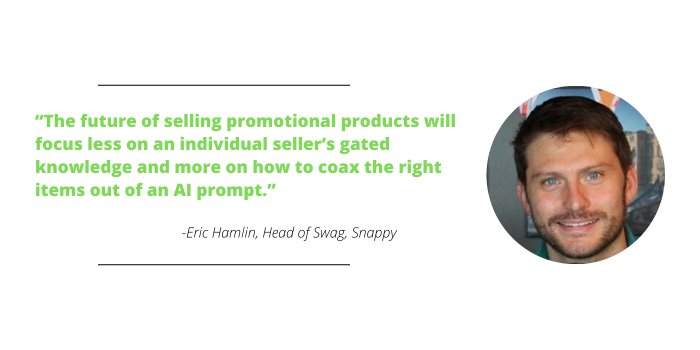 As a result of AI, Hamlin predicts a new generation of sales professionals will emerge.
As a result of AI, Hamlin predicts a new generation of sales professionals will emerge.
“The future of selling promotional products will focus less on an individual seller’s gated knowledge and more on how to coax the right items out of an AI prompt,” he says. “Most LLMs are specifically designed to recognize intent in a prompt and output a human-like response. Successful future sellers will harness this, and experiment with different prompt writing techniques, like asking open-ended questions and clearly stating what or how the response should be formatted.”
Hamlin also predicts that art manipulation and graphic design will become faster.
“I don’t believe that designer jobs will go away, but I do believe that their toolkit will become much more sophisticated,” he says. “Simple tasks like recoloring a design or creating virtual mockups, and even creating vector art, will become easier and more accurate.”
Criticism Of AI
Of course, AI has its fair share of detractors who worry about the repercussions of its immense power.
Critics claim that it will ultimately replace humans in the workforce and limit the collective intellect. To some degree, their fears have already come to fruition: BuzzFeed turned to ChatGPT after cutting jobs earlier this year, and experts estimate that half of college students are already using the tech to cheat.
“Some people get defensive about ChatGPT and think it’s an awful thing to do, but I use it all the time,” says Adrienne Barker, who spent 35 years at Cheshire, Connecticut-based distributor Barker Specialty Company (PPAI 102001, D7), which was co-founded by her parents Herbert and Gloria Barker.
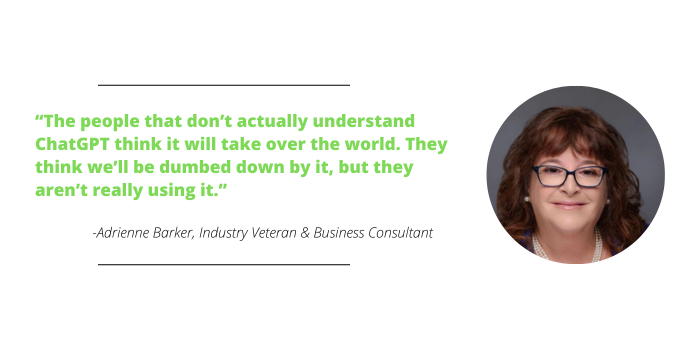 Nowadays, the industry veteran serves as a business consultant to promo firms, using ChatGPT to create her clients’ LinkedIn posts and incorporating AI-generated artwork for their newsletters. “The people that don’t actually understand ChatGPT think it will take over the world,” Barker says. “They think we’ll be dumbed down by it, but they aren’t really using it.”
Nowadays, the industry veteran serves as a business consultant to promo firms, using ChatGPT to create her clients’ LinkedIn posts and incorporating AI-generated artwork for their newsletters. “The people that don’t actually understand ChatGPT think it will take over the world,” Barker says. “They think we’ll be dumbed down by it, but they aren’t really using it.”
For example, Barker says, ChatGPT can enhance your communication strategy. “I’ve seen employees write a message to a client that doesn’t even thank them for their business,” she says. “It’s just like, ‘the product is blah blah blah, send me the artwork.’ Holy crap, where’s your kindness? ChatGPT can do that.”
AI can also help level the playing field for promo firms without the manpower and resources of their larger counterparts. Case in point, Iowa City, Iowa-based distributor Bankers Advertising (PPAI 101972, D8) uses ChatGPT to assist with content for social media, blog posts, newsletter articles, flyers and marketing materials.
“We’re a small, but mighty department and are using ChatGPT as an extension for the team,” says Molly Beavers, CAS, vice president of marketing and communications at Bankers. “It saves us time so we can focus on other projects and create more sales and marketing collateral. As we continue to see the need for faster response times and more promotional opportunities, having the extra support of AI will allow us to continue to meet demands and grow our offering.”
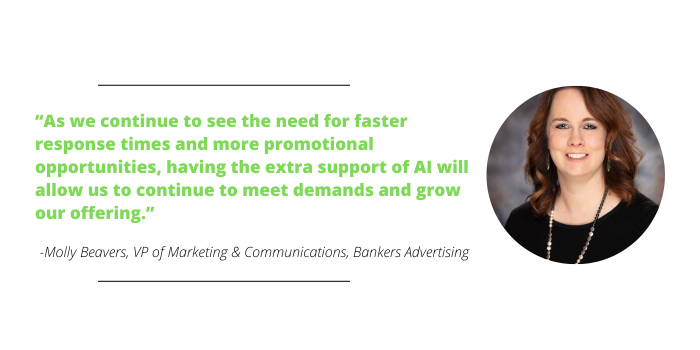 Barker believes that widespread adoption of ChatGPT in the promo industry will depend on business leaders not only encouraging their employees to use it, but also educating them on its capabilities. Similar to classes on cybersecurity and sales techniques, companies should host training sessions on different AI tools, so employees feel comfortable adding them to their repertoire.
Barker believes that widespread adoption of ChatGPT in the promo industry will depend on business leaders not only encouraging their employees to use it, but also educating them on its capabilities. Similar to classes on cybersecurity and sales techniques, companies should host training sessions on different AI tools, so employees feel comfortable adding them to their repertoire.
Will Promo Embrace AI?
As with any new technology, there will be naysayers, early adopters and people sitting in the wings waiting to see what happens.
Hamlin’s advice: take it seriously.
“Become informed and experiment because your competitor will,” he says. “Plus, we’re in this space for a reason – to give our customer something that’s tangible, useful and relevant. If AI improves our ability to do that, then why wouldn’t you be interested in giving it a shot?”
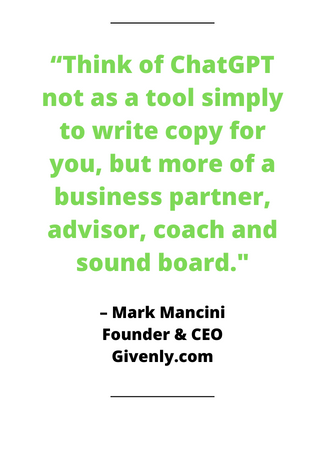 After all, the promo industry – and society in general – has only touched the tip of the iceberg as to what AI can do. “Think of ChatGPT not as a tool simply to write copy for you, but more of a business partner, advisor, coach and sound board,” Mancini says. “Any idea, question or business problem you might have, consider AI as your go-to expert to work through it.”
After all, the promo industry – and society in general – has only touched the tip of the iceberg as to what AI can do. “Think of ChatGPT not as a tool simply to write copy for you, but more of a business partner, advisor, coach and sound board,” Mancini says. “Any idea, question or business problem you might have, consider AI as your go-to expert to work through it.”
Although ChatGPT hasn’t existed for even a year yet, savvy industry pros are constantly experimenting with it to improve their business. As we’ve seen with other technological advances, those who are reluctant to embrace the AI revolution may get left behind.
“People who can use AI tools effectively will save so much time and become so much more efficient,” Gass says. “If you don’t know how to implement and integrate them into your workflow, you’re going to seem so slow in comparison. You’re going to be a dinosaur.”


